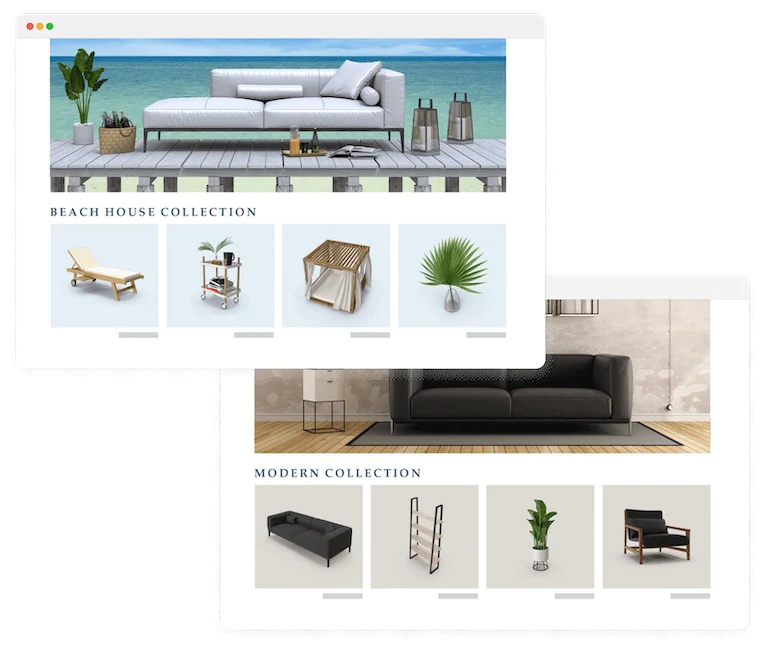In today’s digital age, creating personalized experiences in e-commerce is an essential cornerstone to the success of brands and retailers. This importance goes beyond simple adherence to the latest market trends; rather, it is a ready and adequate response to the growing needs of modern consumers.
We live in a context where personalization is no longer a luxury, but a fundamental request from customers who want to feel unique, appreciated and understood.
At the heart of this trend is an in-depth understanding of consumers as distinct individuals with unique preferences, lifestyles and expectations.
It’s not just about offering quality products, but about creating a bespoke shopping experience, tailored to each customer’s individual needs and journey. In this context, personalization transforms from a mere marketing strategy to a real commitment to establishing authentic and lasting connections with customers.
This evolution is driven by the realization that modern consumers don’t simply want to make purchases, but seek deeper engagement with brands.
Creating personalized experiences not only increases customer loyalty but also builds an emotional bond that goes beyond the single transaction. In a competitive market, where options are abundant, the ability to offer a personalized experience has become a strategic key to differentiating yourself, standing out and winning the hearts and minds of consumers.
The impact of personalization on purchasing
A 2021 report from McKinsey & Company revealed a significant finding: Customers are 76% more likely to consider purchasing from brands that personalize the consumer experience. This data clearly highlights the importance of investing in personalization to increase customer loyalty and stimulate sales.
Effective personalization strategies
Personalized recommendations
Implement advanced algorithms that analyze past user behavior to suggest relevant products. This not only simplifies the purchasing process, but also makes the experience more engaging.
Personalized messages
Utilizzare dati demografici e comportamentali per inviare messaggi mirati. A customer who has already made a purchase might appreciate a special loyalty discount, while a new visitor might be interested in welcome offers.
Intuitive and adaptable interfaces
Create websites and apps that adapt to user preferences. Allowing customization of the interface, such as the arrangement of products or the choice of colors, can significantly improve the user experience.
Personalized loyalty programs
In addition to classic loyalty programs, offer personalized benefits and rewards based on each customer’s purchasing behavior. This not only encourages loyalty, but makes each customer feel unique.
A practical example of customization
If the majority of new shoppers express a predominant interest in sustainable products, it would be prudent to consider including social proof on the homepage to validate this preference. The visibility of sustainability-related testimonials, positive reviews or awards can not only attract the attention of new customers but also solidify the perception of the brand as a leader in the sustainable sector.
On the other hand, for loyal customers who are already familiar with the brand, the ease of finding items related to previous purchases is crucial.
Offering a dedicated section or personalized suggestions based on past purchases can significantly improve the browsing experience and help increase sales by increasing the relevance of the proposals. In this way, a virtual environment is created that responds to the different needs and preferences of customers, promoting a deeper and lasting connection with the brand.
In essence, the success of these strategies lies in the ability to accurately maintain and map buyer personas.
Understanding in depth who new buyers are, their specific interests, and the motivations that drive them towards sustainable products allows you to personalize experiences in a targeted way.
At the same time, monitoring the preferences of loyal customers through effective mapping of buyer personas allows us to anticipate their needs, facilitating access to related products and creating an intuitive and rewarding online shopping environment.
The careful management of buyer personas therefore constitutes the foundation for an effective and results-oriented personalization strategy in the e-commerce sector.
Mistakes to avoid when customizing
1. Focus only on core customers.

– LimeSpot
One of the biggest mistakes big brands often make is assuming that a basic implementation aimed at their core customers is enough and will have a positive impact on all shoppers who visit their site.
However, as Francis Pilon, director of sales at LimeSpot, says, things are different. “Even within a common demographic or targeted product set, visitors have different needs, purchasing goals and purchasing behaviors. ”
Focusing exclusively on a specific type of user creates a tangible risk of excluding other visitor segments, resulting in significant disconnection and poor participation in the brand experience.
When a company limits itself to addressing only a portion of its potential audience, it deprives itself of opportunities to engage a variety of users with different needs, preferences and stories. This limitation can lead to a lack of representativeness of the broad potential customer base, compromising the brand’s ability to build deep and lasting connections with a wider range of consumers.
Therefore, it is crucial to adopt an inclusive approach, aimed at involving and satisfying the different facets of the public, thus ensuring a complete and authentic representation of the brand. Only through a personalization strategy that takes this diversity into account can we hope to build a solid and meaningful connection with the public as a whole.
2. Not adequately tracking site experience data.
It’s a known fact that many businesses neglect to properly track their visitors’ activities on their e-commerce sites, often due to suboptimal Google Tag Manager scripts. Poor tracking management can result in the loss of valuable insights into user behavior, limiting your ability to effectively personalize the shopping experience.
In this context, I highly recommend integrating with HubSpot, a versatile solution that not only improves the accuracy of activity tracking but also offers a wide range of tools for customer management.
HubSpot not only optimizes data collection, but also allows for in-depth analysis of user behaviors, allowing companies to adapt their strategies based on specific customer needs.
Integrating HubSpot with your e-commerce site can be a significant step toward deeper understanding of your audience and more effective personalization of online experiences.
3. Excessive Invasion of Privacy.
In the context of personalization in e-commerce, it is vitally important to find a balance between offering tailored experiences and ensuring that user privacy is respected. Carefully avoid acquiring sensitive information without explicit user consent, and promote transparency in data collection practices.
In addition, companies should implement robust security measures to preserve sensitive customer information from possible data breaches. Data security is an ongoing commitment that requires constant attention to ensure customer trust and protect their privacy.
4. Personalization too superficial.
Go beyond simply using your customer’s name in emails and strive to deepen your understanding of their needs and preferences.
5. Lack of continuous updates.
Changes in consumer tastes and preferences are inevitable over time.
Make sure you regularly update your personalization algorithms to adapt to these evolutions and ensure an experience that is always current and relevant.
6. Exclude the human factor.
Despite technological advances and increasing automation in e-commerce, human interaction remains key. Personalization, although it offers an advanced level of adaptation to customer needs, should not become a complete replacement for the human approach.
Instead, the goal is to harmoniously integrate both elements to deliver a complete experience.
This means that, despite the effectiveness of algorithms and personalized recommendations, human support maintains its irreplaceable role.
Human interaction adds a touch of empathy, understanding and personalization that can be difficult to fully replicate through automation.
Instead of excluding the human factor, personalization should work together with human assistance to create an environment where technology and empathy synergistically integrate, thus improving the overall customer experience.
7. Not showing prices or shipping rates in local currencies.
Research shows that as many as 76% of consumers show a marked preference for making payments in their local currency, thus avoiding any inconvenience associated with generic shipping rates. This aspect goes far beyond a simple preference, representing a crucial consideration in the purchasing phase.
To combat the risk of cart abandonment, it is essential to not only provide clear details about payment options and shipping costs, but also take an active personalization approach based on the user’s location.
Offering a detailed overview of costs in local currency and tailoring shopping experiences based on the specific location of the consumer is a winning tactic to improve transparency and instill trust in the purchasing process, helping to reduce cart abandonment and optimize satisfaction overall customer.
8. Do not pre-populate fields where possible.
The rule is clear: avoid adding extra effort to your customers, especially if you’re trying to offer a seamless and personalized shopping experience. Pre-populating information for customers is key to eliminating friction and improving conversion rates.
9. Personalize experiences based solely on demographic information or past purchases.
Personalization must go further and take into account the current context and behavior of customers. For example, if a customer is browsing on a mobile device, they may have different needs and preferences than if they were browsing on a desktop computer, vice versa.
10. Failing to differentiate based on the customer journey.
Every visitor is unique. We suggest tailoring promotions and recommendations based on what stage of the “customer journey” they are at. Consider whether they are new customers or loyal customers, one-time or repeat visitors, or whether they have spent time exploring the website.
Adapt offers to make the experience more relevant to each type of visitor.
In conclusion
Personalization in e-commerce is more than just a temporary trend; it is a fundamental strategy for ensuring success in the digital world.
Targeted investments in advanced algorithms and sensitive approaches can transform the shopping experience, creating deeper connections between brands and their customers.
Most brands already understand the benefit of segmentation-based personalizations.
However, until recently, only the largest brands had the resources needed to turn that knowledge into actionable insights.
 Fortunately, there are now powerful, affordable, low-effort customization solutions for brands of all sizes, and using a one-size-fits-all model is giving way.
Fortunately, there are now powerful, affordable, low-effort customization solutions for brands of all sizes, and using a one-size-fits-all model is giving way.
Kiosk, a Shopify Partner, is able to create your e-commerce, personalized and specific to your needs and your customers, whether they purchase in physical stores or online.
 | Get off on the right foot.Kiosk helps businesses make the shopping experience as convenient, flexible and compelling as possible. |
 |
Get off on the right foot.Kiosk helps businesses make the shopping experience as convenient, flexible and compelling as possible.
|
Hero banner: Image by Freepik



